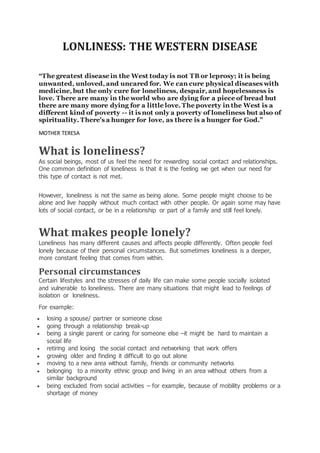
What is loneliness
- 1. LONLINESS: THE WESTERN DISEASE “The greatest disease in the West today is not TB or leprosy; it is being unwanted, unloved, and uncared for. We can cure physical diseases with medicine, but the only cure for loneliness, despair, and hopelessness is love. There are many in the world who are dying for a piece of bread but there are many more dying for a little love. The poverty in the West is a different kind of poverty -- it is not only a poverty of loneliness but also of spirituality. There's a hunger for love, as there is a hunger for God.” MOTHER TERESA What is loneliness? As social beings, most of us feel the need for rewarding social contact and relationships. One common definition of loneliness is that it is the feeling we get when our need for this type of contact is not met. However, loneliness is not the same as being alone. Some people might choose to be alone and live happily without much contact with other people. Or again some may have lots of social contact, or be in a relationship or part of a family and still feel lonely. What makes people lonely? Loneliness has many different causes and affects people differently. Often people feel lonely because of their personal circumstances. But sometimes loneliness is a deeper, more constant feeling that comes from within. Personal circumstances Certain lifestyles and the stresses of daily life can make some people socially isolated and vulnerable to loneliness. There are many situations that might lead to feelings of isolation or loneliness. For example: losing a spouse/ partner or someone close going through a relationship break-up being a single parent or caring for someone else –it might be hard to maintain a social life retiring and losing the social contact and networking that work offers growing older and finding it difficult to go out alone moving to a new area without family, friends or community networks belonging to a minority ethnic group and living in an area without others from a similar background being excluded from social activities – for example, because of mobility problems or a shortage of money
- 2. Loneliness and social isolation in Scotland 17% of older people are in contact with family, friends and neighbours less than once a week and 11% are in contact less than once a month Over half (51%) of all people aged 75 and over live alone Two fifths all older people say the television is their main company 63% of adults aged 52 or over who have been widowed, and 51% of the same group who are separated or divorced report, feeling lonely some of the time or often 59% of adults aged over 52 who report poor health say they feel lonely some of the time or often, compared to 21% who say they are in excellent health The impact of loneliness on health Loneliness is a bigger problem than simply an emotional experience. Research shows that loneliness and social isolation are harmful to our health: lacking social connections is a comparable risk factor for early death as smoking 15 cigarettes a day, and is worse for us than well-known risk factors such as obesity and physical inactivity. What can we do? Fulfil our Vincentian vocation by visiting and befriending those who are lonely, isolated and in need. Take the time to understand their true needs. Ozanam and La Taillandier soon discovered that the old man in the garret did not really need their material help. What he longed for was their time; their friendship and their companionship. Thus he felt valued and respected as an individual, secure in the knowledge that there was a helping hand and a sympathetic ear he could turn to. Raise our awareness of those in our community who are sick, housebound, live alone, new to the neighbourhood and consider how we can befriend them, help them and make them feel useful and valued. Drop in on the sick and housebound for a friendly chat; visit those new to the parish and welcome them and offer practical help and advice. Promote social inclusion and community enrichment by our charitable works. Encourage and support attendance at Masses for the Sick. Lunch clubs provide an opportunity to get out of the house and enjoy a warm meal among friends. Coffee mornings/afternoons allow people to get together, have a chat and some fun. Inter-generational events such as meals, concerts and social events/outings allow young people to plan and provide events which recognise and celebrate the achievements of older people. Such activities enrich both the young and old.